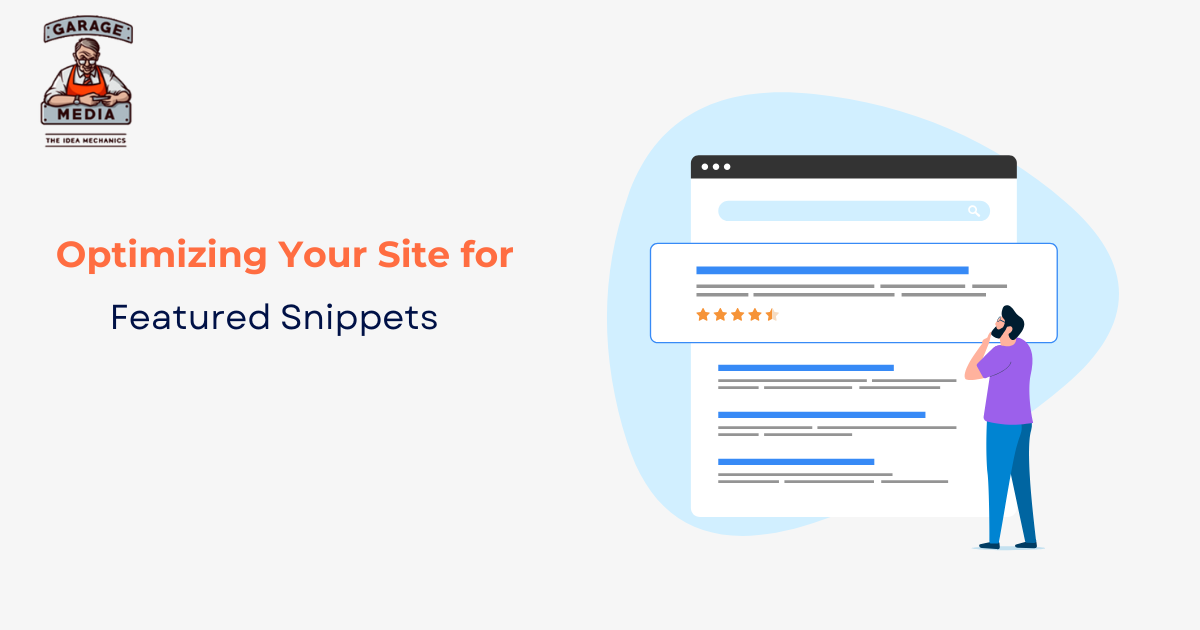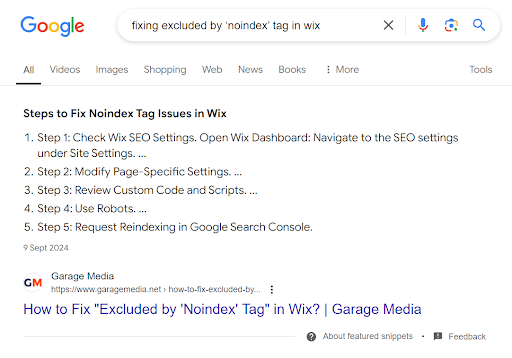
How to Optimize Your Site for Featured Snippets?
In the ever-evolving world of SEO, one of the most desired positions on Google’s search results is the featured snippet, also known as “Position Zero” These snippets give users concise answers, typically in paragraphs, lists, or tables, and can significantly boost organic traffic.
But the question is how to optimize your site or content for featured snippets and why it is important. We’ll answer this with our proven tips, using which we have successfully ranked several content pieces. Join us as we dive into everything you need to know about featured snippets and how to leverage them for your SEO strategy.
How to get Featured Snippets-
What is Featured Snippets?
Featured snippets are short, summarized answers to user queries that appear at the top of Google’s search engine results page (SERP). These snippets are designed to provide users with quick, relevant information without the need to click on any links. The content featured in snippets is pulled directly from web pages that rank on the first page of Google, making it a highly desirable position for any website.
Difference Between Featured Snippets & Rich Snippets?
Rich Snippet: A rich snippet is a search result that contains extra information, such as star ratings, product prices, or images, beyond the standard title, URL, and meta description. It uses structured data (schema markup) to enhance the result visually.
Featured Snippet: A featured snippet is a special box that appears at the top of the search results (position zero) and provides a concise, direct answer to the user’s query. It is usually taken from a webpage Google believes best answers the question.
Types of Featured Snippets
There are several types of featured snippets, each serving a unique purpose depending on the user’s search intent:
-Paragraph Snippets
These are the most common types, where Google displays a short paragraph that answers the user’s query.
-List Snippets
Featured in either numbered or bulleted format, list snippets are ideal for content such as how-to guides, step-by-step processes, or ranked lists.

-Table Snippets
Google may display information in a table format, which is useful for comparisons, pricing, schedules, or data-heavy content.
-Video Snippets
Google can also display a snippet in the form of a video, particularly from YouTube, if the video provides a concise and relevant answer to the user’s query.
Why Are Featured Snippets Important?
Featured snippets offer several benefits that can positively impact your website’s SEO performance:
-Increased Click-Through Rate (CTR)
Even though featured snippets provide users with a quick answer, they often entice them to click through for more detailed information.
Research shows that an average CTR of Snippet Features can achieve an average CTR of 8-12%, significantly higher than standard search results. This emphasizes the importance of optimizing your content for featured snippets to capture more traffic.
-Higher Organic Traffic
A snippet position on Google’s SERP generally results in more visibility, which leads to increased organic traffic.
-Improved Brand Authority
Being featured in snippets establishes your website as a trusted source of information, strengthening your brand’s reputation.
-Voice Search Optimization
Since voice search assistants like Google Assistant often rely on snippets for answers, optimizing for them can improve your visibility in voice search results.
Top 11 Proven Tips to Optimize Your Content for Featured Snippets
Optimizing your content for featured snippets requires a strategic approach to ensure your answers are clear, concise, and relevant. By focusing on user intent and structuring your content effectively, you can enhance your chances of being featured at the top of search results. Here are some actionable tips to help you get started:
1. Conduct Thorough Keyword Research
The foundation of any successful featured snippet strategy begins with in-depth keyword research. Focus on long-tail keywords that are more likely to trigger featured snippets. Tools like SEMrush, Ahrefs, and Google’s Keyword Planner can help you identify keywords with high snippet potential. Look for keywords framed as questions, such as “how to,” “what is,” or “why does.”
Make sure that choose keywords keeping in mind the intent of users.
2. Structure Your Content for Snippets
Content structure plays a critical role in featured snippet optimization. Google tends to prefer content that is well-organized and easy to digest. Here’s how you can structure your content effectively:
Answer the question immediately: Provide a concise, direct answer to the user’s query in the first 50-60 words. This helps Google identify your content as a good candidate for a snippet.
Use headings and subheadings: Organize your content with keyword-rich headings (H2s and H3s) that match user queries.
Bullet points and numbered lists: If the content involves steps, benefits, or lists, use bullet points or numbers to format them.
Tables for comparative data: If you have data that can be presented in a table, do so, as Google often pulls information from tables for snippet display.
Here is an example of one of our blogs being featured in a featured snippet using this same content structure:
3. Use Schema Markup
Schema markup, or structured data, provides additional context to search engines about your content. Implementing schema can increase the chances of Google selecting your content for featured snippets. Focus on applying the correct schema types, such as FAQ schema, How-to schema, or Article schema, to give your content an edge.
4. Write Content Targeted for Voice Search
With the rise of voice search, it’s crucial to optimize your content to cater to voice queries, which often trigger featured snippets. Voice searches tend to be longer and more conversational, so include natural-sounding language in your content. Use questions and answers that mimic the way users speak, and ensure your answers are concise and informative.
5. Provide Comprehensive, In-Depth Answers
While it’s essential to answer queries succinctly at the beginning of your content, don’t forget to provide detailed explanations afterward. Google often selects content that offers both a quick answer and a comprehensive deep dive into the subject matter. Use a mix of short and long-form content to address various aspects of the topic in-depth.
6. Optimize Existing Content for Featured Snippets
You don’t always need to create new content to rank for snippets. Instead, look at your existing pages that are already ranking on the first page of Google and optimize them for snippets. Identify the queries that drive traffic to those pages and modify the content to provide better answers. Ensure your headings are optimized, and that the content is structured in a way that is more likely to be selected by Google.
7. Use Visuals and Diagrams
Google often pulls information from pages that use visuals to enhance the content. Diagrams, charts, and images can help Google recognize your content as informative and valuable. Make sure to optimize all images with alt text and use diagrams that are relevant to the user’s query.
8. Leverage Long-Tail Keywords and Questions
Content that targets long-tail keywords and specific questions tends to rank better in featured snippets. These types of queries are typically more specific and less competitive, making it easier for your content to be selected for snippets. Create FAQ sections on your site or blog posts that answer common user questions related to your industry.
9. Analyze Competitor Snippets
One of the most effective strategies for ranking in featured snippets is to analyze your competitors. Use tools like Ahrefs or SEMrush to identify which snippets your competitors are ranking for and assess how you can create better content to outperform them. Look for gaps in their answers or areas where you can provide more in-depth information.
Techniques to Outrank your competitors…
10. Include FAQs on Your Pages
Frequently Asked Questions (FAQs) are great for triggering featured snippets since they are often formatted in a question-and-answer style.
11. Optimize Paragraph Snippets
For paragraph snippets, aim for answers that are 40-60 words long, providing clear and concise information.
Optimizing for featured snippets requires a strategic blend of content creation, keyword targeting, and on-page SEO techniques. By structuring your content to effectively answer user queries, utilizing schema markup, and continuously improving your existing pages, you can greatly enhance your chances of securing the coveted Position Zero. Keep monitoring your rankings, analyzing competitor snippets, and refining your strategy to maintain visibility and drive traffic growth.
To learn more about digital marketing, SEO, and other aspects of online marketing, visit our blog section. If you’re looking to level up your site’s performance with the best content marketing and SEO practices and boost your rankings on SERPs, contact Garage Media today, we’re the experts you need!
FAQs
Which Search Queries Don’t Trigger Featured Snippets?
Not all queries trigger featured snippets. Generally, queries that are too vague, highly specialized, or lacking clear answers do not trigger snippets. Examples include broad questions like “marketing” or specific queries like “2024 digital marketing trends,” which might not yield a clear answer.
Are Featured Snippets Good for SEO?
Yes, featured snippets are beneficial for SEO. They increase visibility, improve CTR, and establish authority. However, it’s crucial to remember that they may not always result in clicks to your site, as users may find the answers directly in the snippet. Balancing snippet optimization with broader content strategies is essential for sustainable traffic growth.
Featured Snippets vs. Rich Snippets
While both featured snippets and rich snippets enhance search results, they serve different purposes. Featured snippets appear at the top of search results and provide a direct answer, while rich snippets enhance the appearance of standard listings by including additional information like ratings, reviews, or images.
What is the CTR for featured snippets?
The average CTR for featured snippets is approximately 8-12%, making them a valuable asset in your SEO strategy.
How to get featured on Google?
To get featured, focus on high-quality content, optimize for long-tail keywords, structure your content effectively, and leverage schema markup.
How to optimize for rich snippets?
Use schema markup, enhance your content with visuals, and ensure that your content answers user queries effectively to improve the chances of appearing in rich snippets.
